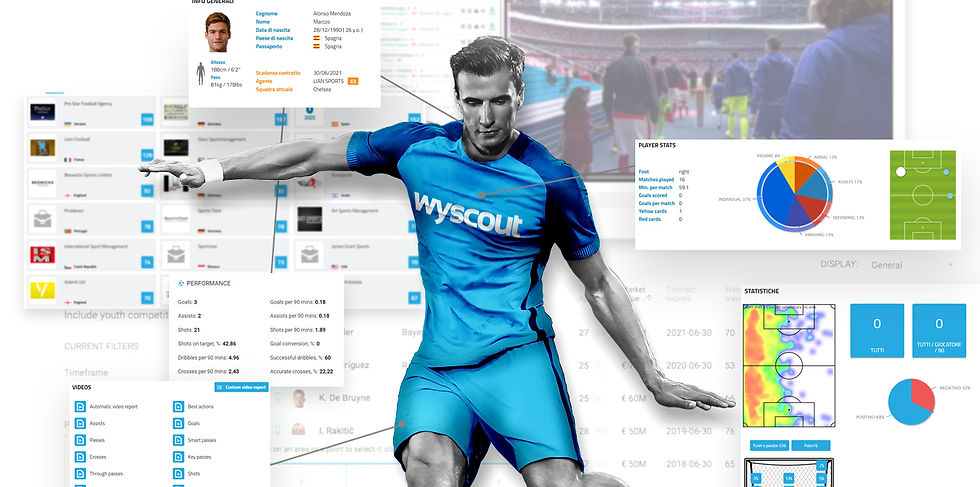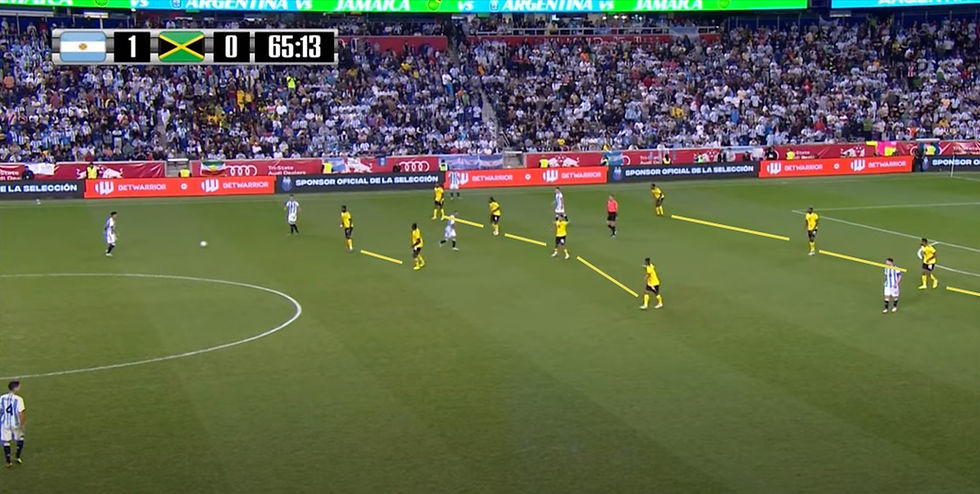Squad Building Principles - Why Barcelona, Real Madrid and Juventus are in financial trouble
- All Angles Football -
- 11 abr 2023
- 10 Min. de lectura

In the football ecosystem in recent years there has been a lot of talk about the sustainability of football clubs, concerns of excessive contracts and wages due to poor squad building and large amounts of money being thrown at the game in addition to clubs facing major financial difficulties such as Real Madrid, Barcelona and Juventus. Barcelona currently have debts amounting to almost €2 billion, while Real Madrid is approaching 1 billion. These financial troubles have seen the three clubs push for a European Super League that would provide them with more financial stability. However, exploring these clubs finances, a lot of these troubles can be attributed to poor squad building over years - especially as wages constitute the majority of these teams' costs and sometimes even surpass their revenue when assessed using a wage to revenue ratio. For example, Barcelona in August 2021 had a wage to revenue ratio of 115%. There is the argument that leagues and governing bodies should regulate these finances and expenditures using various methods such as salary caps, luxury taxes, Financial Fair Play and more. However, apart from that, clubs do have a responsibility to sustainably build squads that can compete but are financially viable. Some principles of doing so are discussed below:
The Preparation and Planning Phase
Data, data and data
Given the emergence of big tech, and the growing use of data worldwide by organizations, football teams now and will only continue to have access to more data than ever. Many teams including Liverpool and Brentford (just to name two) use data for multiple purposes including: scouting, devising tactical formulations, business operations and player fitness. In today’s market the use of data to scout is of utmost importance. Platforms such as SciSports, WyScout and InStat provide clubs with an abundance of data, reports and more on players from regions all over the world (even some that were not as accessible before). This data can be filtered and utilized to find players with specific attributes, characteristics or strengths a club is seeking, that will help the club be more confident of the player being the right fit. The data can also help clubs find undervalued players whom they can improve and/or purchase at a bargain price.
Always be prepared to replace
The football market and industry overall are crazy - to say the least. The situations of teams, players, coaches and other stakeholders can change in a matter of minutes. For this reason, clubs always have to be prepared to replace a player whether the player wants to leave or if/when they receive the right offer to sell the player. The scouting should never stop and clubs should always have a shortlist of two to three targeted, attainable replacements per player/position. This should also include players that are versatile, and able to play multiple positions which can give the team flexibility and help conserve the budget and squad registration restrictions (if any).
Start with the spine and leadership but always strengthen the weakest link
A strong spine with leadership is crucial for any successful team. Look at Italy’s Euro 2020 team and Liverpool’s Champions League and Premier League winning team in 2019 and 2020 - just as two examples. To have leadership and your stronger players in GK, CB, CM and ST are crucial as football is a game that is most often controlled and dictated through the center of the field. Therefore, strong CBs to keep a defense tight as well as technically and physically able CMs are crucial to winning the ball, starting attacks and overall dictating a team’s play.
Although a strong spine is important, it is always important to focus on the weakest link in a team. A chain is only as strong as its weakest link and therefore it is important for teams to strengthen the weakest link through multiple avenues that are possible such as:
Devising a tactical plan that strengthens the weak link or covers his/her weakness/vulnerabilities
Finding a replacement in the transfer market
Developing a youth product
For example, in the Euro 2020, it could be argued that Giovanni Di Lorenzo was the weak link of the Italy side that won. This was exposed in the game against Belgium as Jeremy Doku was selected by Roberto Martinez to go up against Di Lorenzo and definitely gave him a troubling time, even forcing Di Lorenzo to concede a penalty. It could even be interpreted that Mancini selecting Di Lorenzo as the one of the two full backs to stay back in the system, rather than go forward and attack (Spinazzola), would be a means of covering Di Lorenzo as the weak link considering that Bonucci and Chiellini were both there for cover during the defensive phase of play and if Di Lorenzo was able to mostly attack, he is not as capable of running back and defending as Spinazzola was. It is all about formulating a system/tactic to cover the weaknesses and play to the strengths of the players and team overall.
Maintain strong, healthy relationships
The football market might be spread across the globe but given globalization and technology is easily accessible. Many agents, sporting directors, coaches and other stakeholders in the market often know each other, have good relationships and if not as mentioned, are easily accessible. For this reason, it is important to keep valuable relationships with clubs, players, coaches and agents to prevent a potential transfer from not being possible or falling through. These relationships can have agents or clubs turn to you first when they are looking to get their player a new location and should that be a player of interest to your team - that good relationship might give you the upper hand. For example, the relationship between Jorge Mendes and Wolves has seen Wolves able to sign numerous players since their ownership change that has played a role in the team’s promotion to the Premier League and its relative successes since promotion.
Be prepared to help the player relocate, settle and adapt
Players might be technically excellent, a perfect tactical match to a team’s system and the perfect overall target. However, if that player is not able to easily relocate, settle and adapt into their new environment, that player won’t be the same, and won’t live up to expectations and perform at the level they ought to. The mental aspect most definitely has a major effect on physical performance. Therefore, it is crucial that agents and clubs work together to ensure players smoothly settle into new environments when arriving at a new club, to ensure optimal performance. Something that is being done more and more often recently and is an excellent idea is to have a separate team or individual working at the club, that is dedicated to working on this situation for players. This occurred with Angel Di Maria when he signed for Manchester United, his inability to settle and adapt to life in Manchester and develop a healthy relationship with the club - saw his tenure become a short-lived disaster.
Limit wages as a % revenue
Clubs excessively spending on player wages over recent years have caused severe financial issues in these clubs such as Barcelona, who were earlier mentioned to have a wage to revenue ratio of 115%. Barcelona are now struggling and in the worst position the club has been in, on and off the field, in many years. These issues saw club legend Leo Messi offloaded, summer signing Emerson Royal being transferred after two months to satisfy La Liga’s salary cap which is specific to each team based on their revenue and squad costs. Generally, a team’s wage to revenue ratio should ideally be around 60% or less, absolute maximum 70%. However, this is not often seen as for example in the 2019/20 season, Premier League teams had an average wage to revenue ratio of 73%. Liverpool, who won the Premier League that season, had a ratio of 66%.
Selling and Buying at the Right Time and the Right Age
An important factor for managers, sporting directors and other parties involved in squad building should consider is timing. It is important to know when to sell a player and when to buy whether this be related to the market, recent successes or failures, international tournaments, age or contracts.
Sell at or before 30
One major issue many clubs make is handing players over 30 years old, lengthy contracts that involve high wages and compensation. Generally, performance declines after 30 (arguably except for goalkeepers). However, recently due to scientific advancements and data, some players are often able to delay this although it is inevitable. A good rule of thumb is in most cases to not give players over 30 a major lengthy contract - which is why Liverpool actually did not renew Wijnaldum’s contract earlier this year. A player will usually peak in his mid to late 20s, and if the player’s contract is soon expiring it would be good to offload and replace between 28 and 30 years old for a transfer fee which can be reinvested. Many times these transfer fees will even be a profit should the player have been signed at a younger age or from a less prominent club for a lower fee. The return on investment after 30 generally declines and minimizes value for the club as generally at least the same amount (mostly more) is being spent on a lesser return from the player.
Buy between 22 and 24
Before or after selling between 28 and 30 - the best age to purchase a replacement is around 22 to 24 years old. This is generally speaking an age where players will be about to enter or are already at their peak. Considering this, an ideal (although the market is not ideal) situation would be to plan ahead bring in a player around/between the ages of 21 and 25 to be a replacement for a player approaching between 28 and 31 who will be offloaded to being acclimatizing and learning the team system and environment, so that, when the player is offloaded the player is ready to step into the starting role. For example, this was seen with Rodri being signed by Man City in the summer of 2019 in anticipation of Fernandinho leaving or requiring.
Sell when offered more than the player’s worth (be as eager to sell as to buy)
If prepared to replace, it should never be a problem to sell. Teams should be as eager to sell as eager to buy. For example, when a team is able to buy an attractive player on a bargain there will be much excitement and eagerness to buy. However, the same should apply when offered more than a player’s value. If a team has attainable replacements prepared/targeted, the team should be more eager than hesitant to sell the player and replace him as they are being offered more than the player’s value. However, this is a very controversial principle for good reason as often times depending on the player, even if offered higher than the player’s value - some players are just invaluable and indispensable to their teams.
“Buy” when contract is up or running out
An excellent time to “buy” a player is when his contract is expired or about to expire. 6 months before his contract expires, he can negotiate a deal with a new team for a free transfer. However, even before that if there is only a year remaining on his contract, his value will be significantly less than if there is say 3 years left. Therefore, a good time to acquire a player is when you are able to negotiate a deal with him 6 months or less before his current contract ends or sign him on a bargain if his contract has 12 months or less left on it and you know there would be interest towards joining your club.
Buy when undervalued
A good strategy towards buying players is also when the player is undervalued. The following are good examples of situations when players can be undervalued and could potentially be purchased at a bargain:
Bad club situation
This can vary from if the club is in a poor financial crisis and is in dire need of cash/money to if the club is loosing on a poor run or was relegated and the player wants out or lastly if the player is not fitting in at his club on or off the field and/or is having disciplinary issues. The disciplinary issue is a situation that should be very well scrutinized as players with disciplinary issues can ruin their own potential and fail to live up to it, take Mario Balotelli, Ravel Morrison or Adriano for example. However, if a club is absolutely confident that a player’s disciplinary issues can be settled due to the environment/culture at the club, potentially a sports psychologist at the club and the club is willing and able to invest resources to clear these issues with the player, the player could be bought at a bargain and provide much value should the disciplinary issues be resolved. However, it is a very big risk.
Data
As mentioned earlier, data is of the utmost importance and can help find the right fit of a player and provide a wider scouting region. Additionally, data can be used to find players who are playing at a very high level or have very high potential but are under the radar due to the league or team they currently play in, or just generally not being a well known reputable name but is able to be developed and/or be the star and make a name for himself in a new team. Data can help find these players who can be bought at a low price and sold at a higher price and have a huge impact on teams. For example, take the Brentford model with Ollie Watkins or Liverpool with Andy Robertson and even Leicester with Mahrez and Kante. Data was used and can be used to find these types of players.
Forwards and nationalities are overvalued
It is important to note that forwards, and certain nationalities such as Brazilians, Germans, Spanish and other big nations are often overvalued just because of the fact that forwards score goals, provide assists and that these nationalities are also big footballing nations. Yes, often times and most times it is unavoidable but it is something to be mindful of.
Don’t buy based on major tournaments
After major tournaments, if a player performed very well, his value will sky rocket. Take for example, James after the 2014 World Cup in Brazil. However, this sample of 4 to 7 games is not enough to justify teams/clubs paying extraordinarily high prices just because of a major tournament. Firstly, these tournaments are only a very small sample of what the player is actually capable of and secondly, right after the tournament the player will be overvalued and therefore it is important to take this into consideration if ever faced with this sort of situation. However, on the selling end it may be a good time to sell especially if looking to or the time is right to offload the player.
** Some of the research and concepts here are suggested by Stefan Syzmanski and Simon Kuper in their book Soccernomics, which is a must read.**




Comments